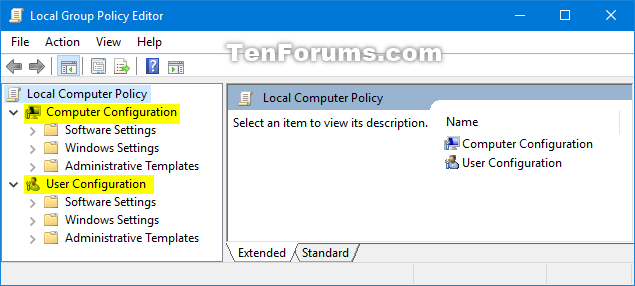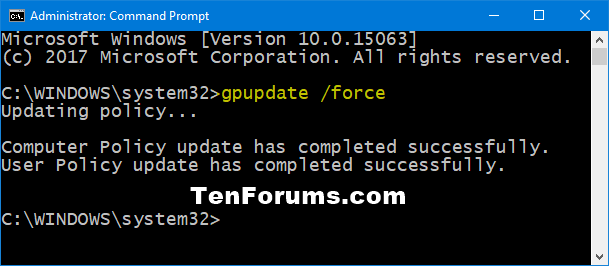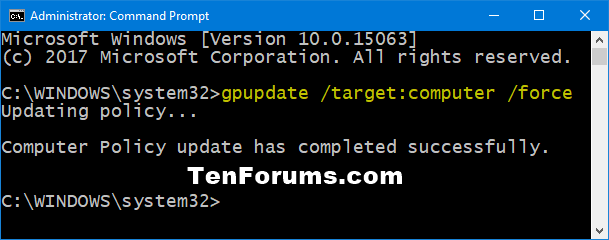How to Manually Update Group Policy Settings in Windows 10
The Local Group Policy Editor (gpedit.msc) is a Microsoft Management Console (MMC) snap-in that provides a single user interface through which all the the Computer Configuration and User Configuration settings of Local Group Policy objects can be managed.
By default, computer and user Group Policy are updated in the background every 90 minutes, with a random offset of 0 to 30 minutes. In addition to background updates, Group Policy is always updated when the system starts.
After you make changes to group policies, you may want the changes to be applied immediately without waiting on the default refresh interval above to do so.
If you set group policies using Registry Editor on a local computer, then you may want to update group policy settings on the computer without having to restart the computer.
This tutorial will show you how to manually force an update of computer and user Group Policy settings in Windows 10.
You must be signed in as an administrator to update Group Policy settings.
gpupdate command usage:
Syntax: gpupdate [/Target:{Computer | User}] [/Force] [/Wait:<value>] [/Logoff] [/Boot] [/Sync]
Parameter Description /Target:{Computer | User} Specifies that only User or only Computer policy settings are updated. By default, both User and Computer policy settings are updated. /Force Reapplies all policy settings. By default, only policy settings that have changed are applied. /Wait:{value} Sets the number of seconds to wait for policy processing to finish. The default is 600 seconds. The value '0' means not to wait. The value '-1' means to wait indefinitely. When the time limit is exceeded, the command prompt returns, but policy processing continues. /Logoff Causes a logoff after the Group Policy settings are updated. This is required for those Group Policy client-side extensions that do not process policy on a background update cycle but do process policy when a user logs on. Examples include user-targeted Software Installation and Folder Redirection. This option has no effect if there are no extensions called that require a logoff. /Boot Causes a computer restart after the Group Policy settings are applied. This is required for those Group Policy client-side extensions that do not process policy on a background update cycle but do process policy at computer startup. Examples include computer-targeted Software Installation. This option has no effect if there are no extensions called that require a restart. /Sync Causes the next foreground policy application to be done synchronously. Foreground policy applications occur at computer start up and user logon. You can specify this for the user, computer or both using the /Target parameter. The /Force and /Wait parameters will be ignored if specified.
Contents
- Option One: To Update Both Computer and User Group Policy Settings
- Option Two: To Update Only Computer Group Policy Settings
- Option Three: To Update only User Group Policy Settings
EXAMPLE: Computer and User Group Policies
1 Open an elevated command prompt.
2 Copy and paste the command you want to use below into the elevated command prompt, and press Enter. (see screenshot below)
(Updates only changed policy settings)
gpupdate
OR
(Updates all policy settings)
gpupdate /force
1 Open an elevated command prompt.
2 Copy and paste the command you want to use below into the elevated command prompt, and press Enter. (see screenshot below)
(Updates only changed computer policy settings)
gpupdate /target:computer
OR
(Updates all computer policy settings)
gpupdate /target:computer /force
1 Open an elevated command prompt.
2 Copy and paste the command you want to use below into the elevated command prompt, and press Enter. (see screenshot below)
(Updates only changed user policy settings)
gpupdate /target:user
OR
(Updates all user policy settings)
gpupdate /target:user /force
That's it,
Shawn
Related Tutorials
- How to Open the Local Group Policy Editor in Windows 10
- How to See Applied Group Policies in Windows 10
- How to Apply Local Group Policy to Administrators in Windows 10
- How to Apply Local Group Policy to Non-Administrators in Windows 10
- How to Apply Local Group Policies to Specific User in Windows 10
- How to Backup and Restore Local Group Policy Objects in Windows 10
- How to Reset All Local Group Policy Editor Settings to Default in Windows 10
- How to Add Local Group Policy Editor to Control Panel in Windows
Update Group Policy Settings in Windows 10

Update Group Policy Settings in Windows 10
How to Manually Update Group Policy Settings in Windows 10Published by Shawn BrinkCategory: Security System
16 Apr 2020
Tutorial Categories


Related Discussions






